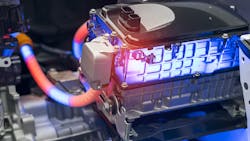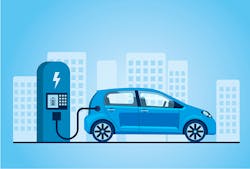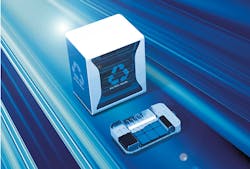EV Battery Chemistry and Its Impact on the Electronics Industry
This article is part of the TechXchange: EV Battery Management
What you’ll learn:
- What are the barriers to wide-scale adoption of electric vehicles?
- The different types of battery alternatives.
Electric vehicles (EVs) are surging ahead, with new startups like Byton, Canoo, and Rivian entering the arena each year to follow Tesla's lead. In the meantime, automotive bluebloods GM and Ford have committed $7B and $11B (respectively) to defend their market-leading positions. Moreover, Europe and China paced the global markets with over one million new registrations in 2020. On top of that, the cost of EVs, long said by EV opponents to be a deal-breaking challenge, is coming down as supply ramps up. Nonetheless, significant technical and commercial challenges remain.
The industry wants to know when electric cars will be available for everyone. It’s essential to understand the limiting component to answer that question, both from an economic and a technology perspective. The battery pack is the most expensive component in an EV, consuming 30% of the total cost to battery electric vehicle (BEV) and plug-in hybrid electric vehicle (PHEV) consumers.
Still, with vehicle demand exponentially increasing, the cost per kilowatt-hour (kWh) is exponentially decreasing, down to $137/kWh at the end of 2020. BloombergNEF estimates that at $100/kWh, electric cars will soon be at cost parity with gasoline-powered vehicles.
Now that battery cost is on the decline, the key problems to solve are charging time and total range. Drivers expect a refueling time of around five minutes or less, which becomes the unofficial benchmark for EV charging. The battery chemistry and charging infrastructure will dictate how quickly a driver can charge an EV.
There’s no clear choice for the best battery technology within the battery segment. Lithium-ion (Li-ion) dominates the market, but market alternatives offer exciting value propositions, including some technically superior to Li-ion.
But if the automotive industry genuinely shifts toward electric cars, the sharp increase in battery production will create unprecedented demand for minerals to make the batteries. Because many existing battery chemistries overlap with consumer electronics, it also will significantly impact that market. As a result, there will be tension in the supply chain for competing priorities over mineral supply between the two industries at the highest level.
The "winning" EV battery chemistry would ideally de-risk mineral supply while providing the technical and environmental benefits that EVs can deliver. Below is a review of how the leading battery alternatives affect electronics.
Leading Battery Alternatives
The overwhelming majority of EV batteries are Li-ion-based. Li-ion's liquid-state technology works by employing lithium to carry the electric charge between the electrodes. To put the scale of EV batteries into perspective, they use 10,000X the amount of lithium of mobile phones, ramping up the demand for lithium and driving up its commodity price.
However, Li-ion is not without its challenges. Thus, battery manufacturers are developing alternatives, paced by nickel metal hydride (NMH), lead-acid, ultracapacitors, and solid-state batteries.
Li-Ion
One of the biggest reasons electric-vehicle manufacturers prefer lithium-ion battery technology is its high power-to-mass ratio. Heavy components are the enemy of range, as the battery uses too much energy starting and stopping a heavier vehicle instead of traveling a further distance per charge.
In addition, Li-ion batteries have high energy density and better performance than their alternatives at elevated temperatures. Li-ion's use in the consumer electronics industry is partly responsible for the high energy density.
The decreasing size of electronics and the desire for longer operating hours per charge spurred innovation in this parameter. As a result, Li-ion's energy density is more than 2.5X greater than both NMH and lead-acid batteries. In addition, Li-ion batteries are recyclable, making them a good choice for environmentally focused consumers.
Lithium batteries consist of:
- A cathode (source of lithium-oxide ions) that determines the capacity and voltage of the battery.
- An anode (releases lithium ions) that enables electric current to flow through to an external circuit.
- An electrolyte (comprised of salts, solvents, and additives), a medium that enables the movement of ions between cathode and anode. It’s what gives the name to the battery type ("Li-ion" means lithium carries the ions).
- A separator to prevent direct contact between the anode and the cathode.
These benefits are why Li-ion is the preferred technology for consumer electronics. However, automotive applications demand specific energy (expressed in W-h/kg). These demands are substantially more severe than for consumer electronics, prompting the US Advanced Battery Consortium (USABC) to develop energy targets. These targets and the plateauing progress in improving energy density indicate that scientists may need to create or consider new materials to meet the energy demand.
Changing or modifying the Li-ion battery chemistry for EVs may affect the cost, supply chain, and availability of the new materials for non-automotive applications.
Nickel Metal Hydride (NMH)
While Li-ion is the standard for all-electric vehicles (AEVs), NMH is better suited for hybrid electric (HEVs) and plug-in hybrid electric vehicles (PHEVs). Though NMH has a better lifecycle than Li-ion or lead-acid, the chemistry brings its share of tradeoffs.
NMH batteries are less expensive than Li-ion but experience higher self-discharge rates when not in use. They also generate substantial heat at the hotter end of the operating range. Rejecting excess heat reduces range and shortens product life cycles. This technology also risks undesired hydrogen loss that manufacturers and consumers must monitor and control.
Though seemingly unlikely, an uptick in NMH demand for EVs would affect cell phones, computers, and similar electronic devices. In addition, power tools often use NMH batteries, so a shift in demand or availability of minerals could significantly impact the construction industry.
Solid-State Electrolytes
The clear winner for liquid-state electrolytes is Li-ion, especially with the percentage of BEVs likely to substantially increase in the coming years. But Li-ion is sensitive to cost swings due to market movement and reshuffling, along with skyrocketing demand.
In addition, there’s an opportunity to improve the top safety concern of flammable liquid catching fire. Safety is one of the most critical success criteria for EVs to inspire public confidence, so industry and safety regulators would likely welcome an opportunity to step up the safety features.
Solid-state batteries (comprised of lithium metal) address the most pressing safety challenges of Li-ion using essentially the same chemistry. Solid-state technology utilizes a solid disc electrolyte, whereas Li-ion employs a liquid. Long thought by many engineers and materials scientists to be the long-term solution for EVs, devices like pacemakers, radio-frequency identification (RFID), and wearables already use solid-state technology.
Solid-state batteries are more stable, have a higher energy density than the already high-density Li-ion, come from readily available materials, offer lower flammability and faster charging, and improve and extend the performance range of EV batteries. For these reasons, solid-state batteries seem like the future.
Barriers to Wide-Scale Adoption
Solid-state is seemingly the future of EV batteries, but developers must solve some of the challenges to widescale adoption. Solid-state batteries will carry a higher development cost due to a lack of capital to produce mass quantities. It’s crucial to get this cost down to encourage consumers to purchase cars with these kinds of batteries.
Gaps in the solid Li electrolyte material degrade battery performance and service life when implemented into BEVs. In addition, solid-state batteries are prone to cracking and like to charge at 60°C for optimal performance.
Another challenge was that a condition of high electrical resistance existed between the positive electrode and the electrolyte. Researchers learned that annealing (heating at a specific temperature over a particular amount of time) in combination with preventing exposing the electrolyte to water vapor brought the resistance back in line.
As with any development material, it will be critical for the manufacturing process to be efficient. There hasn’t been a mass-produced solid-state battery for electric vehicles to date. As a result, manufacturing challenges through lack of experience with the solid electrolyte material would substantially delay wide-scale adoption. A manufacturing issue also could cause the EV battery plant to shut down, delaying the majority of the public's first interaction with the new battery and affecting consumer confidence.
The need to anneal and shield the solid material from water vapor may influence how engineers apply this technology. The extra steps to condition the electrolyte could enable the design for mass production. Still, it may add lead times to components using the material and add conditioned storage costs to avoid exposure to water vapor.
Conclusion and Takeaway
EVs are changing the way we think about batteries. Engineers are challenging previous realities like specific energy limits and materials of construction. The extra demand for EV charging, safety requirements, and efficiency goals may disrupt the electronics industry, closely tied to electric vehicles, through their battery technology. Understanding how EVs' economic and technical developments influence electronics and other related markets is essential for seamless implementation.
Read more articles in the TechXchange: EV Battery Management
About the Author
Adam Kimmel
Technical Content Writer, Mouser Electronics
Adam Kimmel has nearly 20 years as a practicing engineer, R&D manager, and engineering content writer. He creates white papers, website copy, case studies, and blog posts in vertical markets including automotive, industrial/manufacturing, technology, and electronics. Adam has degrees in Chemical and Mechanical Engineering and is the founder and Principal at ASK Consulting Solutions, LLC, an engineering and technology content writing firm.


